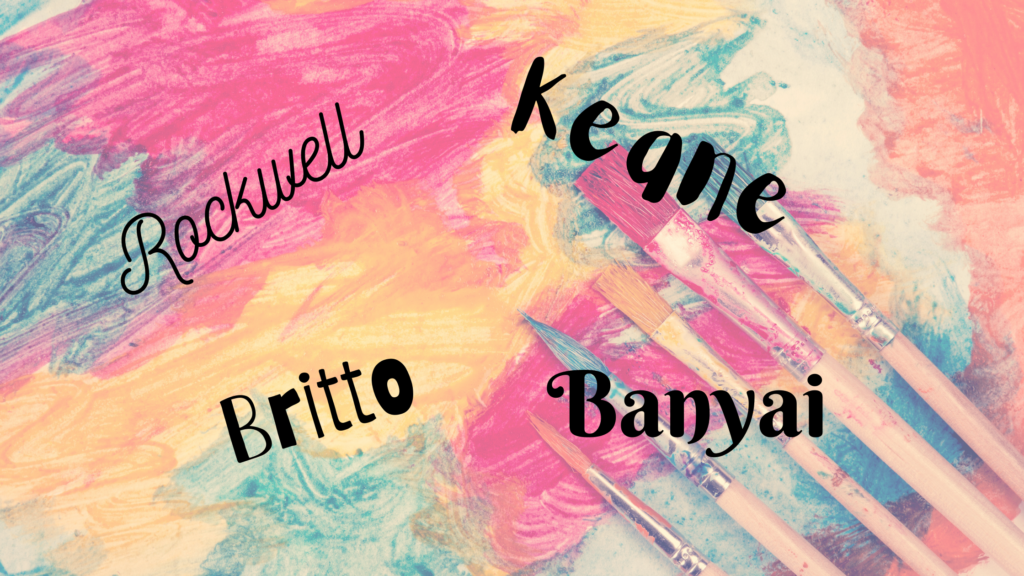
Arts Integration has been around for a while, but somehow it still seems a bit overwhelming to use in school counseling classroom lessons. As counselors, we may be creative and love doing art projects, but we are not experts in visual arts, drama, dance, or music. This causes our lessons to contain little more than drawing and coloring activities with a splash of playdough here and there. And let’s face it, it is a bit boring for you to teach and a bit boring for your students. Luckily, there are easy ways to ramp up your arts integrated counseling lessons. Use visual art to teach emotions and social stories. Four artists that I love to use in my counseling lessons are Norman Rockwell and Margaret Keane.
- Margaret Keane ( Empathy) Look up any piece by Keane and you will see that a majority of her paintings have large eyes. A great lesson for empathy would be to take one of her paintings and have the students tell the story of the person in the paintings. Ask students “Who was this person?”, “Where do they live?”, “What is their life like?”. Think of other questions that might pertain to what the person was like regarding their life, experiences, feelings, etc. Have a meaningful discussion about how students feel towards the person in the painting. For an arts integrated activity, have students create a person inspired by Keane and have them share the personal story of their creation.
2.Norman Rockwell ( Body Image) Rockwell is so good at showing social interactions and psychological circumstances that children are experiencing. One of his paintings, Girl at Mirror, depicts the social pressure of young girls to look a certain way. Even though the painting was created in 1954, many of the same body image topics still linger today. When using this painting with students, spark a conversation with the concept of “See, Think, Wonder”, which is a visual thinking strategy used to inspire conversation and comprehension. While looking at Girl at Mirror, ask students what that see in the painting itself. What colors are used? What shapes or shadows do you see? What do you think is going on in the painting? Why do you feel that way? What do you notice in the painting that makes you feel that way? What do you wonder about in the painting? What questions do you have about the painting or the artist?By analyzing Rockwell’s painting, you are opening up an authentic experience for students to share their own thoughts, opinions, and feelings on the topic of body image.
3. Romero Britto (Gratitude) Romero Britto’s style of painting is so much fun and so bright. In a gratitude lesson, students reflect on the concept of gratitude and create what they are grateful for in the style of Britto. You can use the painting Britto Garden as and example. In this painting, there are so many different images, one can’t help think that his garden was a place of happiness and gratitude when he created it. Something else fun to do is to take pictures of some of the students’ creation and posting them on social media and tagging the artist. How much fun would it be to get a response from the artist directly!
4. Istvan Banyai ( cooperation). This artist is also an author. He has published two books called Zoom and Re-Zoom. The books are used nontraditionally in this lesson because all of the pictures in each book are cut out and laminated. The artist/illustrator has created Zoom and Re-Zoom as a visual exploration around various images. In the book itself, each painting zooms in or out ( depending on the order you look at the images) into another painting until at the very end, there is a totally different lesson. Each book has about 30 visual images that are all connected. For the lesson, cut out and laminate all of the images form one of the books, Zoom and Re-Zoom. Mix them all up and give students one or two of the pages until all have been passed out. Tell students “These pictures go together. You have to work together to figure out how.” Traditionally, students will get in small groups at first and then realize that they have to work with everyone in the class to put the book back together visually. After the book has been put back together in the correct way, we talk about the perspective of the artist’s work. We then talk about what made cooperation hard. ( Not working together, some people trying to control the process, some people checking out totally, etc. ). This is such a fun lesson to connect to art and students love it!
Arts Integration does not have to be scary. It can be a fun and creative expression of self and others. Get comfortable with being uncomfortable and have some fun! If you are interested in pre made arts integration lessons, check out my School Counseling Workbook through Youthlight Inc